
SU MMER 2 02 3 CO NNE CT ICUT
TrailsTurnsDay 30
Land Acknowledgment Statement
CFPA acknowledges we are on the traditional lands of the Mashantucket Pequot Tribal Nation, the Mohegans, the Eastern Pequot, Schaghticoke, Golden Hill Paugussett, Nipmuc, and Niantic peoples. We pay our respect to the Indigenous people who are no longer here due to colonization, forced relocation, disease, and warfare. We thank them for stewarding this land throughout generations. We recognize the continued presence of Indigenous people on this territory who have survived attempted genocide, and who still hold ties to the land spiritually and culturally. We shall be good stewards of the land we all call Quinnentucket, Connecticut.
CONTRIBUTOR’S
Spotlight
Radim Schreiber has spent the past 15 years photographing fireflies. The Czech-born photographer, now based in Iowa, has won numerous awards for his work and his images have been featured in magazines and exhibitions around the world. But for Schreiber, photographing fireflies is more than just a job. “I believe that fireflies have power to connect with various cultures and bring connection and understanding among them,” he says. We caught up with Schreiber to learn more about his photography and passion for fireflies.

What inspired your firefly project?
When I was in college, I was excited about photographing insects and creating large portraits of them. The idea came to me to photograph a firefly on a blade of grass with the moon behind it. This idea was in my mind for many years until the (camera) technology improved. I was able to take the first
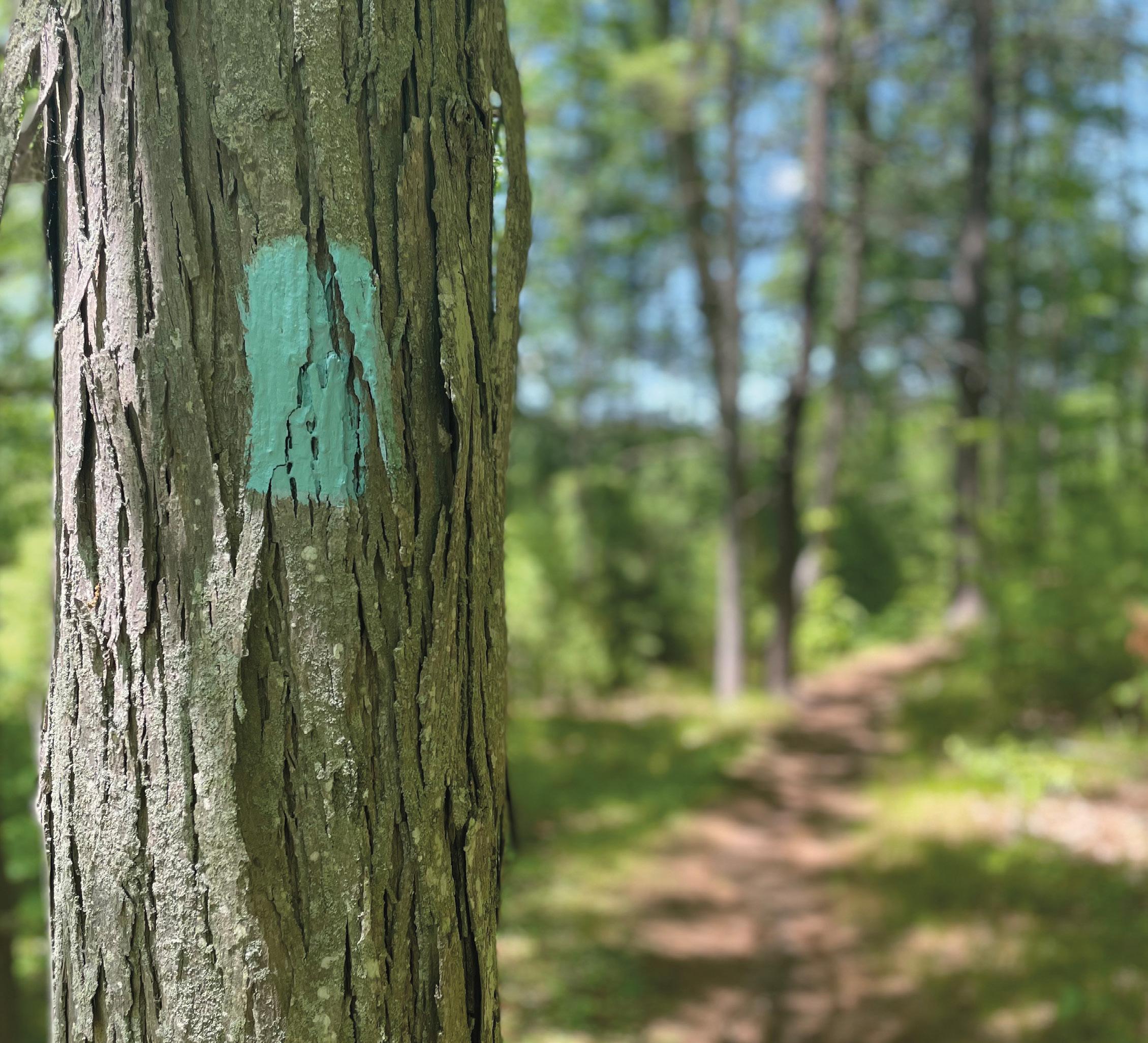
2 Connecticut Woodlands
Summer 2023 Volume 88/No. 3/ISSN #00106257
4 Editor’s Note
5 From the Statehouse
By Eric Hammerling
7 On the Trail
By Kathy Carlson
9 Oak Storm
By Amy Nawrocki
10 Trails Day Turns 30!
12 Delightful Lights
By Laurie D. Morrissey
16 Many Paths Up the Mountain
By Greg Gregory
18 Floods, Fires, and Food:
Combating Eco-anxiety in a Changing Climate
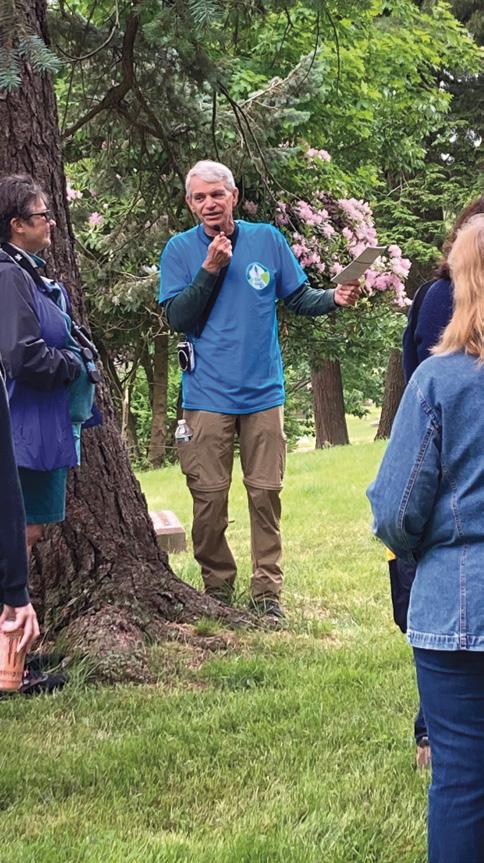 By Jennifer Sprague
By Jennifer Sprague
20 CFPA Updates
23 Pathways
couple of shots in my garden in 2008. I was very excited and purchased the latest camera the next year and spent the whole summer photographing fireflies. One of my photographs, "Amber Firefly," won the Smithsonian photography contest, which gave me a boost to become a professional firefly photographer.
You've said that growing up in the Czech Republic you didn't see many fireflies. What is so special to you about these creatures?
Yes, there are very few fireflies in the Czech Republic and most people have never seen them; children don't have the memories of catching them like people in the United States. I really wanted to see their light up close on a photograph. During my years of photographing fireflies, I have learned so much about these little beetles. Mostly, I enjoy the experience of watching fireflies at night. Night can be scary, but fireflies bring joy and magic into the darkness.

What advice do you have for other aspiring nature photographers?
Firefly photography is not much different than night photography. I use a tripod and cable release for my landscape long exposure photographs. For the macro photographs, I slowly approach a firefly flashing on a blade of grass and hope to catch the moment the firefly flashes. You gotta be very patient because dozens of shots don't turn out well and you may be annoyed by mosquitoes and chiggers. Good luck on your magical journey of taking photos of fireflies!
facebook.com/ctforestandparkassociation
twitter.com/ctwoodlands

instagram.com/ctforestandparkassociation
860-346-TREE
ctwoodlands.org
info@ctwoodlands.org
ctwoodlands.org 3
On the cover: Hikers explore Tanager Hill Preserve at Penwood State Park in Simsbury on Connecticut Trails Day. Photo by Jake Koteen.
In this Issue
Editor’s Note
When I first heard that Eric Hammerling was leaving CFPA for a new position at DEEP, I was stunned and saddened. Eric has served as Executive Director for the past 15 years. As editor of Connecticut Woodlands, I’ve come to rely on his advice, creativity, and editorial savvy, and like many of you, on a personal level, I’m proud to call him my friend.
Eric’s commitment to safeguarding Connecticut’s parks, forests, and trails is well known. But he is equally committed to expanding equity and access to open spaces and to making public lands safe and welcoming for all. His leadership on CFPA’s JEDI (Justice, Equity, Diversity, and Inclusion) Advisory Council has been critical to advancing these values throughout the organization, including on the pages of this magazine.
June is Pride Month and cities throughout Connecticut are hosting performances, parades, and other celebrations honoring the LGBTQ+ community. But across the country, LGBTQ+ folks are increasingly targets of discrimination and violence. Transgender individuals, in particular, have been the focus of conservative lawmakers and radical hate groups who are working to roll back legal protections for trans healthcare and other civil rights. This kind of discrimination is both immoral and deeply un-American, but unfortunately nothing new. And for far too long, environmentalists have either remained silent on social justice issues or have actively supported policies that perpetuate segregation and discrimination on public lands based on one’s race, gender identity, sexual orientation, nationality, or economic status. While Connecticut is currently a relatively safe state for LGBTQ+ folks, it is incumbent upon each of us to take an active role in protecting and defending the civil liberties of all Americans.
Many environmental organizations, including CFPA, have taken significant steps to address racism and injustice and improve equity, but we still have a long way to go to ensure that everyone feels a sense of belonging in the great outdoors. And while I’ll miss Eric and wish him all the best in his new career, his departure presents CFPA with an opportunity to select a new executive director who represents those who have historically suffered discrimination, oppression, and hate due to their identity or background.
I’ll see you outside,
Timothy Brown Editor
The Connecticut Forest & Park Association, Inc.
The Connecticut Forest & Park Association (CFPA) is a 501c3 nonprofit organization that protects forests, parks, walking trails, and open spaces for future generations by connecting people to the land. Since 1895, CFPA has enhanced and defended Connecticut's rich natural heritage through advocacy, conservation, recreation, and education, including maintaining the 825-mile Blue-Blazed Hiking Trails system. CFPA depends on the generous support of members to fulfill its mission. For more information and to donate, go to ctwoodlands.org
Board of Directors
President
R. Richard Croce, Groton
Vice-Presidents
Kristin Connell, Killingworth
David Terry, East Hampton
Treasurer
William Cordner, Simsbury
Secretary
Eric Hammerling, West Hartford
Forester
Jeffrey Ward, Prospect
Robyne Camp, Middletown
Laura Cisneros, Mansfield
Beth Critton, West Hartford
Robert Deptula, Ellington
David Ellis, Wallingford
Laurie Giannotti, Deep River
Alan Hurst, East Hampton
Seth Huttner, Hartford
Peter Knight, Stonington
Michael Proctor, Sandy Hook
Tom Tella, Wolcott
Marcus Ware, Ellington
Staff
Eric Hammerling
Executive Director
Beth Bernard
Education Director
Alex Bradley
Trails Field Coordinator
Clare Cain
Trails Director
Linda Pierce
Development Director
Danuta Kozak
Office Manager
Jeb Stevens
Trails Protection Coordinator
Meaghan Strange
Development Assistant
Connecticut Woodlands
Timothy Brown Editor

Margaret Gibson
Poetry Editor
Kolk Design
Graphic Design
Thanks to photo contributions from Clare Cain, Kathy Carlson, Greg Gregory, Jake Koteen, Sara Lewis, Radim Schreiber, Trails Day leaders and photographers
Sustainably printed on FSC certified paper using solar power and LED-UV curable inks, which don’t release harmful VOCs into the atmosphere and can reduce energy consumption by 30% compared to conventional inks.
Connecticut Woodlands is a quarterly magazine published since 1936 by CFPA. The magazine is distributed to members and donors, as well as public libraries and other state and local offices. Advertising local goods or services is welcome. For specifications and rates, visit ctwoodlands.org/rates. To advertise, contact info@ctwoodlands.org or call 860-346-TREE.
4 Connecticut Woodlands
From the Statehouse
By Eric Hammerling
Happy Trails to You
IT’S BEEN AN HONOR to serve as CFPA’s Executive Director for the past 15 years and I’m excited for CFPA’s future. But in June, I will begin a new career at the Connecticut Department of Energy and Environmental Protection (DEEP). Clare Cain, CFPA’s Trails Director, will serve as interim executive director as the board conducts a search for a permanent replacement.
There are too many people to acknowledge properly here, but in terms of advocacy, I must give special thanks to CFPA’s lobbyist, John Larkin, without whom many of the following accomplishments would not have been possible.
■ In 2009, Congress designated the New England National Scenic Trail, or NET, as one of only 11 national scenic trails in the nation. Our ongoing work on the NET, in partnership with the National Park Service and Appalachian Mountain Club, has inspired us to “think big,” an approach that benefits the entire Blue-Blazed Hiking Trails network.
■ In 2010, the Metropolitan District Commission nearly closed its lands to public recreation due to liability concerns. In 2011, CFPA led a coalition
of partners to fix the state’s recreational liability law to ensure that MDC lands and other municipal recreational lands would remain open to the public.
■ In response to the “October Nor’easter” and Tropical Storm Irene—both storms knocked out power in large swaths of the state—in 2012 I was asked to chair the State Vegetation Management Task Force, which included electric utilities, forest and tree professionals, and forest conservation advocates. With support from DEEP’s forestry division, we developed consensus recommendations to both ensure healthy roadside forests and increased electric reliability. Our report led to several pieces of legislation, such as establishing public notice requirements for utilities when doing vegetation management and further professionalizing municipal tree wardens with education requirements.
■ Today the “Passport to the Parks” program annually generates more than $20 million for operations and maintenance of state parks. Starting in 2018, the Passport eliminated entrance fees to state parks and forests for all Connecticut residents.
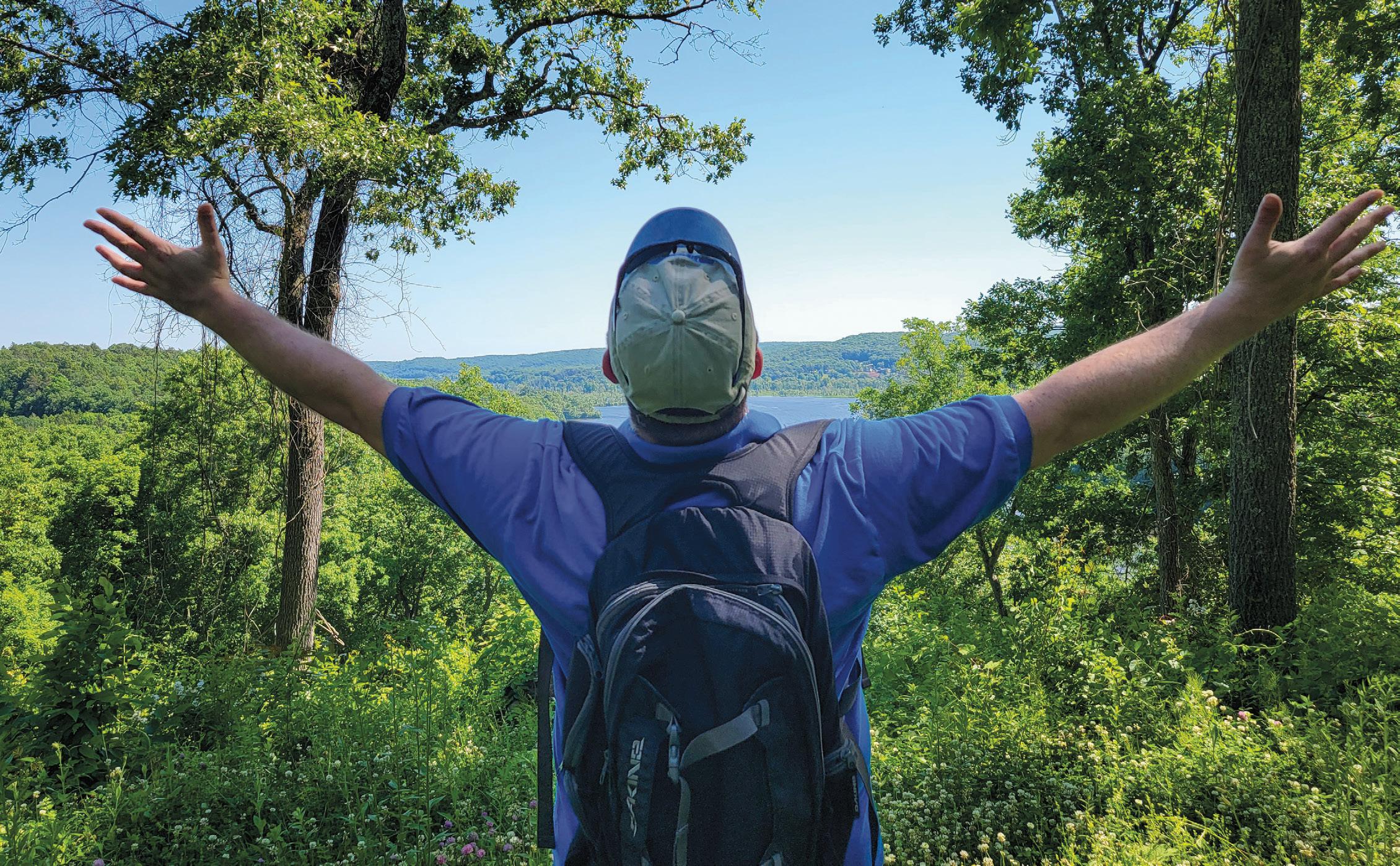
Key Advocacy Accomplishments for CFPA over the past 15 years
2009 New England National Scenic Trail designated by Congress as one of only eleven national scenic trails in the nation. (P.L. 111-11, Section 5202)
2011 Recreational Liability Statute amended to extend existing protections against legal liability enjoyed by individual landowners to municipalities. (P.A. 11-211)
2011 10-Mill program statute amended to ensure that landowners responsible for ~17,000 acres of forestlands would not face a large increase in property taxes automatically triggered at the 50-year mark of being in this 100-year forest conservation commitment. At the 50-year mark, property taxes are now equivalent to the P.A. 490 property tax valuation for forestland rather than being based upon a new revaluation of the land and its standing timber. (P.A. 11-198)
2012 State Vegetation Management Task Force Report published with consensus policy and funding recommendations to balance healthy roadside forests and reliable electricity.
ctwoodlands.org 5
2013 New process established for public notice by utility companies conducting vegetation management with abutting landowners and municipalities. (P.A. 13-298)
2013 New requirement for municipal tree wardens to become qualified either by successfully completing tree warden coursework, or by being a licensed arborist. (P.A. 13-203)
2015 State bonding approved for Recreational Trails & Greenways grant program. (P.A. 15-1)
2017 Passport to the Parks program authorized by the CT General Assembly (P.A. 17-2)
2018 Passed resolution in General Assembly with sufficient 3/4ths vote in both chambers to allow Question #2 protection of public lands to be placed on the statewide ballot. Question #2 was approved with 85% public support. (Resolution Act 18-1)
2020 CFPA Chairs Forests

Sub-group Report to the Governor’s Council on Climate Change with consensus recommendations and background on the importance of forests in mitigating and adapting to climate change.
2021 CFPA Chairs Policy on Resilient Forests for Connecticut’s Future (PRFCT Future) report to find consensus on forest conservation recommendations amongst 15 diverse organizational stakeholders.

2023 15 New Park Maintainers supported through the Passport to the Parks in FY 2024-25 Budget. New incentives approved for municipalities to encourage private landowners hosting trails to make long-term commitments to public access (SB 998). New state goal of increasing urban tree canopy by 5% by 2040 in Connecticut cities and environmental justice communities (SB 896).
With greater equity and access to our state parks and forests since the expensive gate fees were removed, attendance has soared to all-time highs.
■ CFPA led efforts to amend the state constitution to address concerns that the State was routinely passing “conveyance bills” to sell, swap, and give away public lands to municipal or private interests with no public debate. With strong encouragement from CFPA, the CT General Assembly supported a referendum on the statewide ballot requiring that: 1) public lands could not be conveyed by the Legislature without a public hearing; 2) conveyance proposals must be presented as individual bills rather than as a package of bills; and that 3) state parks, forests, and other public lands held by DEEP or the Department of Agriculture could only be sold, swapped, or given away after a two-thirds supermajority vote. The referendum to amend the state constitution, known as “Question #2,” passed with 85 percent support in November of 2018.
■ For several years, CFPA has made the case that both funding and people are required for Connecticut to adequately care for its forests, parks, trails, and open spaces. Although there have been successful efforts to secure funding, it has been more difficult to increase human resources. Adequate numbers of field staff are needed for many reasons, but especially to meet the additional demands as state park attendance has doubled from 8.4 million visitors in 2016 to over 17 million today. A proposal to add 15 Park Maintainers to keep parks and forests open and safe for visitors was included in the final FY 2024-25 budget.
■ We hope the important role of forests in mitigating and adapting to climate change will be both better recognized and supported, perhaps through a statewide “no net loss of forest” policy. Indeed, we risk falling behind other states as the challenges to our forests from climate, forest pests, and fragmentation continue to grow.
Finally, I encourage you to visit ctwoodlands.org and read through CFPA’s new three-year Strategic Plan. You’ll notice there is a LOT of important work to do for advocacy, education, land conservation, and trails. As you know, this work doesn’t happen without a strong “trunk” and “roots” bolstered by your support and engagement to accomplish CFPA’s mission. Thanks very much and happy trails to you!
6 Connecticut Woodlands
The Quinnipiac Trail: From Gaylord Mountain Road to Route 42
By Kathy Carlson
On a warm June day in 1971, a friend and I hiked a blue-blazed trail in northern Hamden to a vista point on Mt. Sanford in the Naugatuck State Forest. The rocky trail climbed steadily and was challenging in the afternoon heat, but we hiked as if we had wings on our feet—we were celebrating our high school graduation! At the summit, we were rewarded with a cool breeze and an expansive view of the hills and woodlands to the west. We sat up there and took it all in. I didn’t know the trail’s name, but I liked its quiet, remote feel. Little did I know that this was just the beginning of a decade’s long connection with this trail.
Hiking has been my favorite outdoor activity for as long as I can remember. I love exploring an environment by walking on a trail that I’m drawn to aesthetically, emotionally, and physically. From my college years on, I hiked whenever, wherever, and with whomever possible on trails from Connecticut to Maine. It was when I began hiking with my friends Ginny and Bob Dowd that I became familiar with the Blue-Blazed Hiking Trail System. They were avid hikers and active members of CFPA and its Trails Committee. They led hikes, organized “work parties,’’ and maintained sections of several different Blue-Blazed Trails. We bonded over our love of trails and hiking and logged many miles together on trails around the state: Macedonia Brook,
Mohawk, Nipmuck, Metacomet, Mattatuck, Mattabesett, Paugusset, and others. These excursions increased my understanding of and appreciation for Connecticut’s expansive trail system and CFPA’s role in making it all possible.
The Dowds encouraged me to participate in work parties. At that point in my life, free time was limited and precious. I would have rather been hiking on trails, not maintaining them. However, my attitude changed over time, and I grew to enjoy the camaraderie of other volunteers and a sense of reward for “giving back to the trails.” I learned about the effort required to plan, construct, and maintain them.

ctwoodlands.org 7
Although I was developing an appreciation for trail maintenance, trail management was not something that I actively sought; rather it found me following the sudden death of longtime Quinnipiac Trail manager, Howard Bassett, in the fall of 1987. Since I had some (albeit limited) experience and lived in close proximity to the trail, I was recommended for the position. The rest, as they say, is history. Since February 4, 1988, I have been the Trail Manager for the section of the Quinnipiac Trail and the associated Sanford Alternate Trail that pass through the Sanford Block of the Naugatuck State Forest.
My long-term commitment to this trail has truly been a labor of love. Like spending time with an old friend, I never tire of “visiting” the lovely summit ridge of Mt. Sanford. In spring, I know just where to look for certain wildflowers such as columbine, hepatica, and ginger. The hardy chestnut oaks and red cedars that grow in those dry, challenging conditions never cease to amaze me. And while the view from the overlook may change with the seasons, you can always count on a refreshing breeze up there. (In winter, it can feel like an arctic blast!) Judging from the entries made in a hiker log that is posted at the overlook, it’s evident that this spot is special to other people too. Another spot that has special meaning to me is the footbridge that crosses Sanford Brook. Built by my husband from native red cedar, the bridge has withstood numerous severe weather events and continues to provide a safe crossing for hikers.
Volunteering on the trail over the years has provided me with the opportunity to observe changes in the surrounding forest and to the trail itself. Weather events, including a tornado, and the spread of invasive insects like the woolly adelgid and emerald ash borer, have changed the character of the woodlands. The demise of most of the hemlocks and ash trees that once provided deep shade have left a forest that is now much more open and exposed. Blowdowns across the trail occur more frequently than in the past and must be cleared. The trail itself has changed due to necessary relocations and a dramatic increase in use. The resulting trail widening and erosion present challenges that require a variety of mitigation strategies to improve the trail’s durability.
My longevity as a trail manager can also be attributed to the fact that I truly enjoy doing the work that is a necessary part of maintaining a trail. There is a meditative quality to many of the tasks, however routine they may seem. Working quietly while painting blazes, sidehilling, or trimming overgrown vegetation along the trail requires me to focus on the task at hand. Without even trying, I find that I am “in the moment.”
While past and present hiking experiences have brought me to some spectacular places, it is always a pleasure to return to the Quinnipiac Trail. Now, after looking after it for 35 years, the time is right to pass the honor of being its trail manager to someone new. I sincerely hope that my efforts, along with those of other volunteers and friends who have joined me in working on trail projects, have made it a place that hikers enjoy traveling and want to return to when they seek an outdoor experience.
Kathy Carlson is a retired educator who lives in Hamden with her husband and favorite hiking partner, Dave. She attributes her love of the outdoors to her parents who gave her lots of freedom to explore the woods and farmland around her childhood home.

8 Connecticut Woodlands
Find the complete map in the Connecticut Walk Book, published by CFPA and Wesleyan University Press.
N
Oak Storm
Amy
Nawrocki
It’s been like this for a while now, waiting for storms to pass over. The end of winter brought no snow; the end of spring brought no rain. The waiting brought no end to the wait.
The storm tracked its lovely radar in predictable spirals of yellow and red, and perennial thunder waited too—like a criminal, not yet detectable except to weathered men and beasts underground.

And when the squall began its quarreling the oaks began to shake away the August heat and leave the waiting to the rest of us. They fell together—leaves twined like bundled magazines, glossy and unselfconscious; their color print pages so full of summer, so unperturbed by the descent. There were too many to name: Eastern white oak, Northern red oak, Black oak, mossy cup oak, chestnut oak, shrub oak, swamp oak, scarlet oak— veins still plump, leaf blades leathery like the shed skin of snake gods who fear the rain. At the end of waiting, I gather as many as I can carry, and I bury them in the pages
of frail human books. I need so badly to hold in their storm scent, to remember petrichor, the weight of wind now quiet, the electricity of their dark Eden-green so green, green like the sound of thunder just as the earth breaks its fall.
Amy Nawrocki is the author of six poetry collections, most recently Mouthbrooders (2019), which was a finalist for the 2021 Connecticut Book Award. Her work has appeared in many publications including The Connecticut River Review, Woven Tail Press, and Sixfold. Her nonfiction book, The Comet’s Tail: A Memoir of No Memory, was Foreword Review INDIES finalist for best memoir and was awarded a Gold Medal for the Living Now Mind-Body-Spirit Awards. She teaches English at the University of Bridgeport and lives in Hamden.
ctwoodlands.org 9
Trails Day Turns 30!
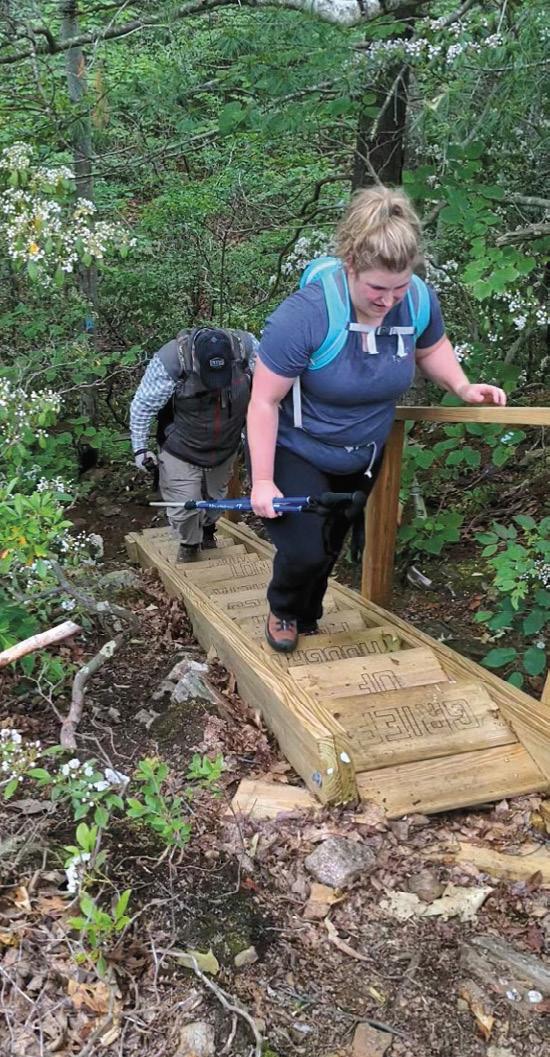

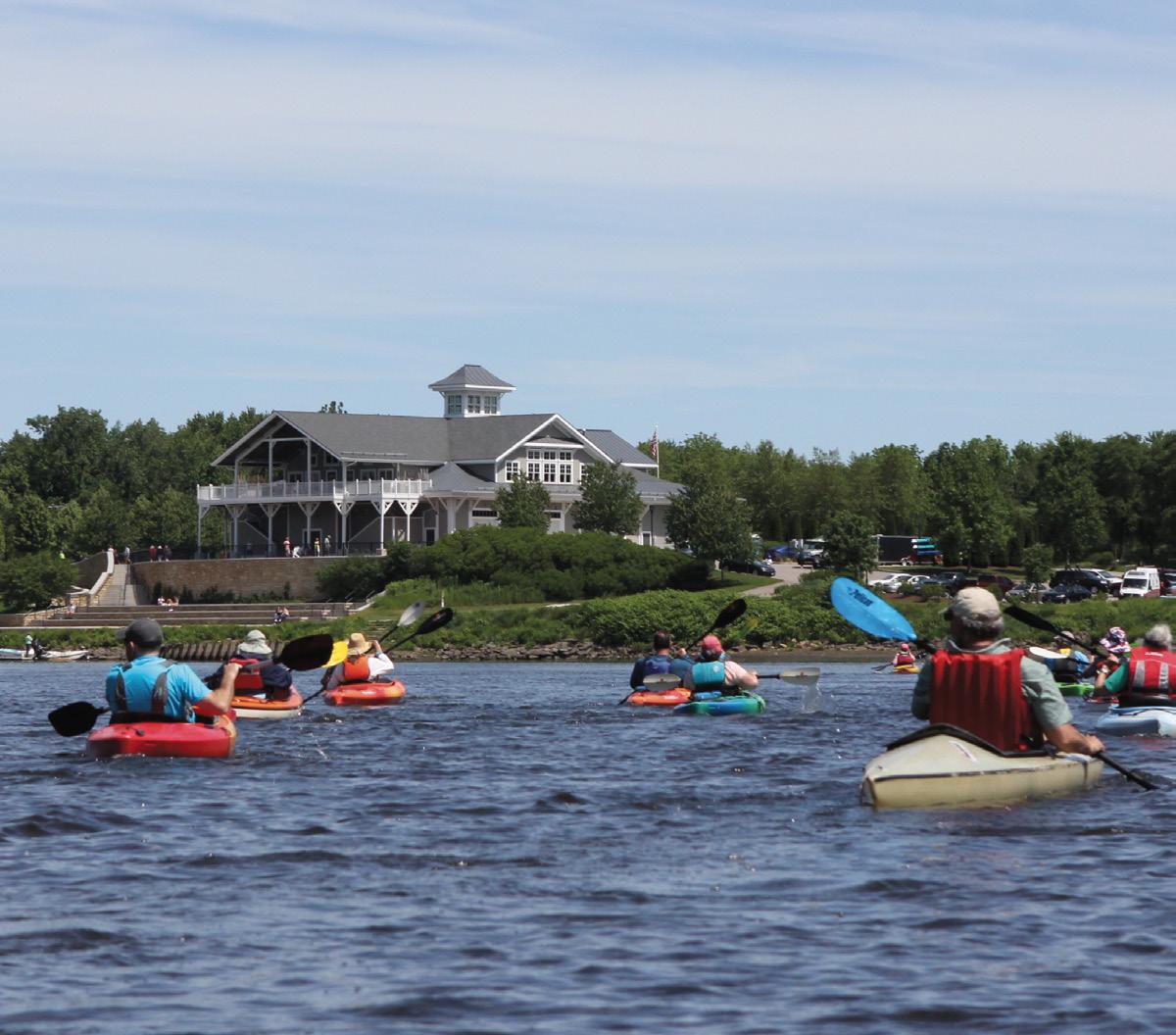

This June, Connecticut Trails Day celebrated 30 years as the nation’s largest annual Trails Day celebration with over 190 events across 100 towns. From sunrise hikes and searching for amphibians, to kayaking with bald eagles, tagging horseshoe crabs, repairing foot bridges, discovering native wildflowers, family bike rides, and learning about Connecticut history, there was something for everyone. Thank you to all the Trails Day event leaders and participants for making this such a success!
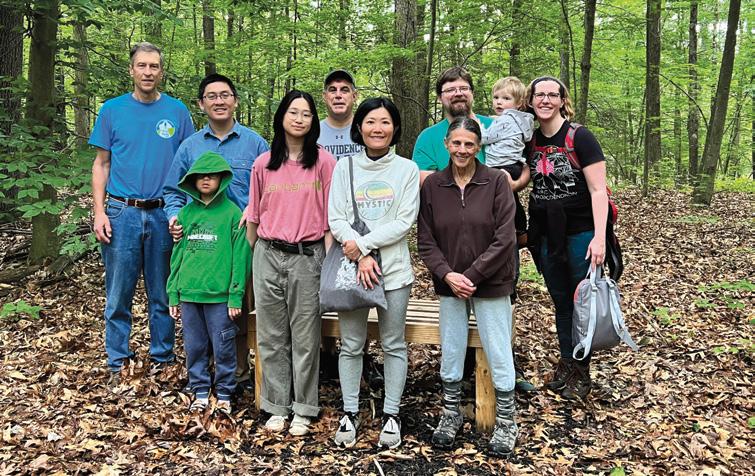
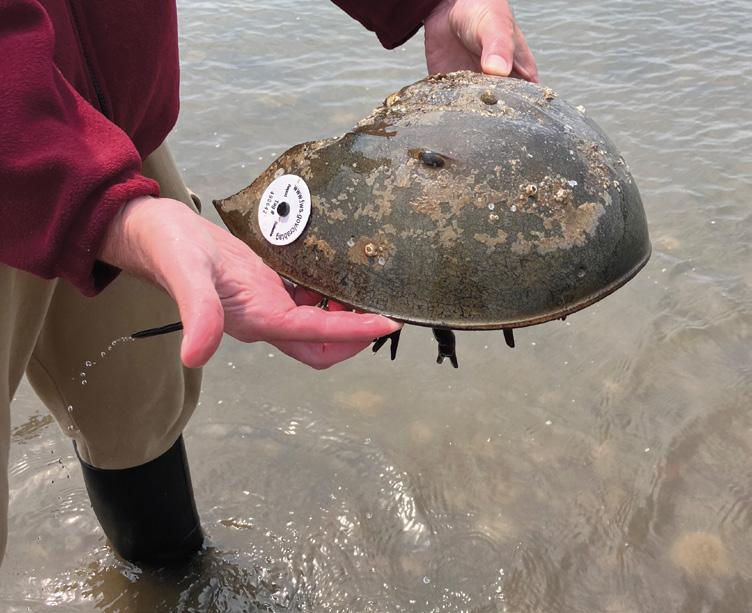
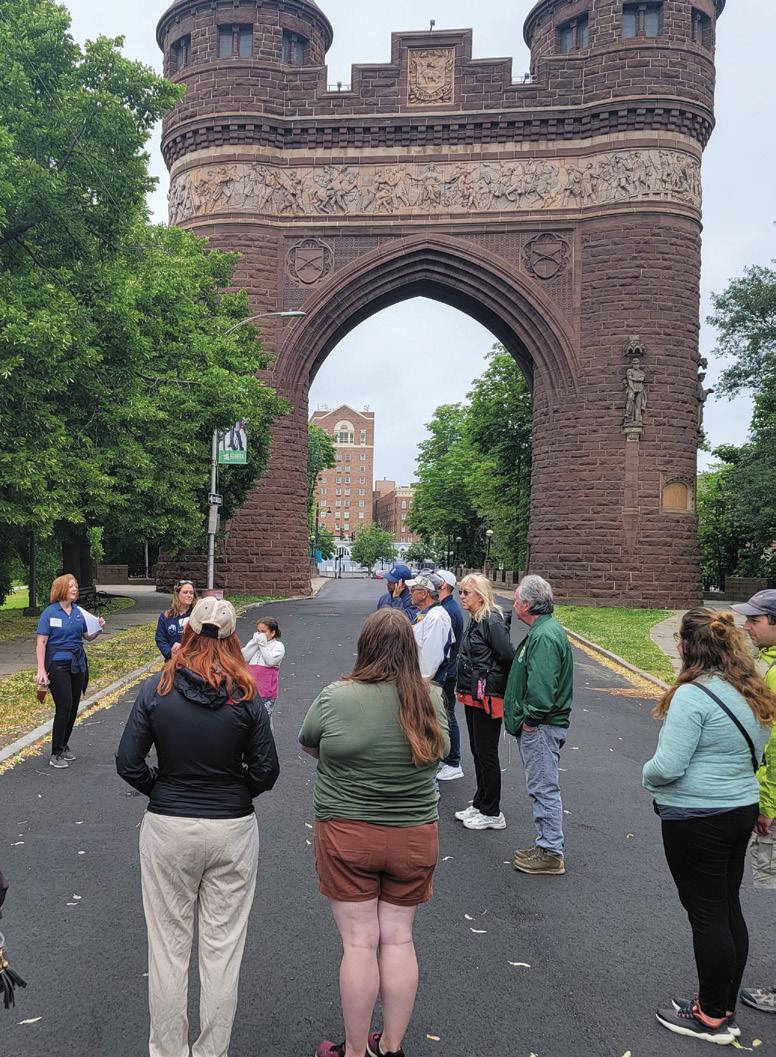

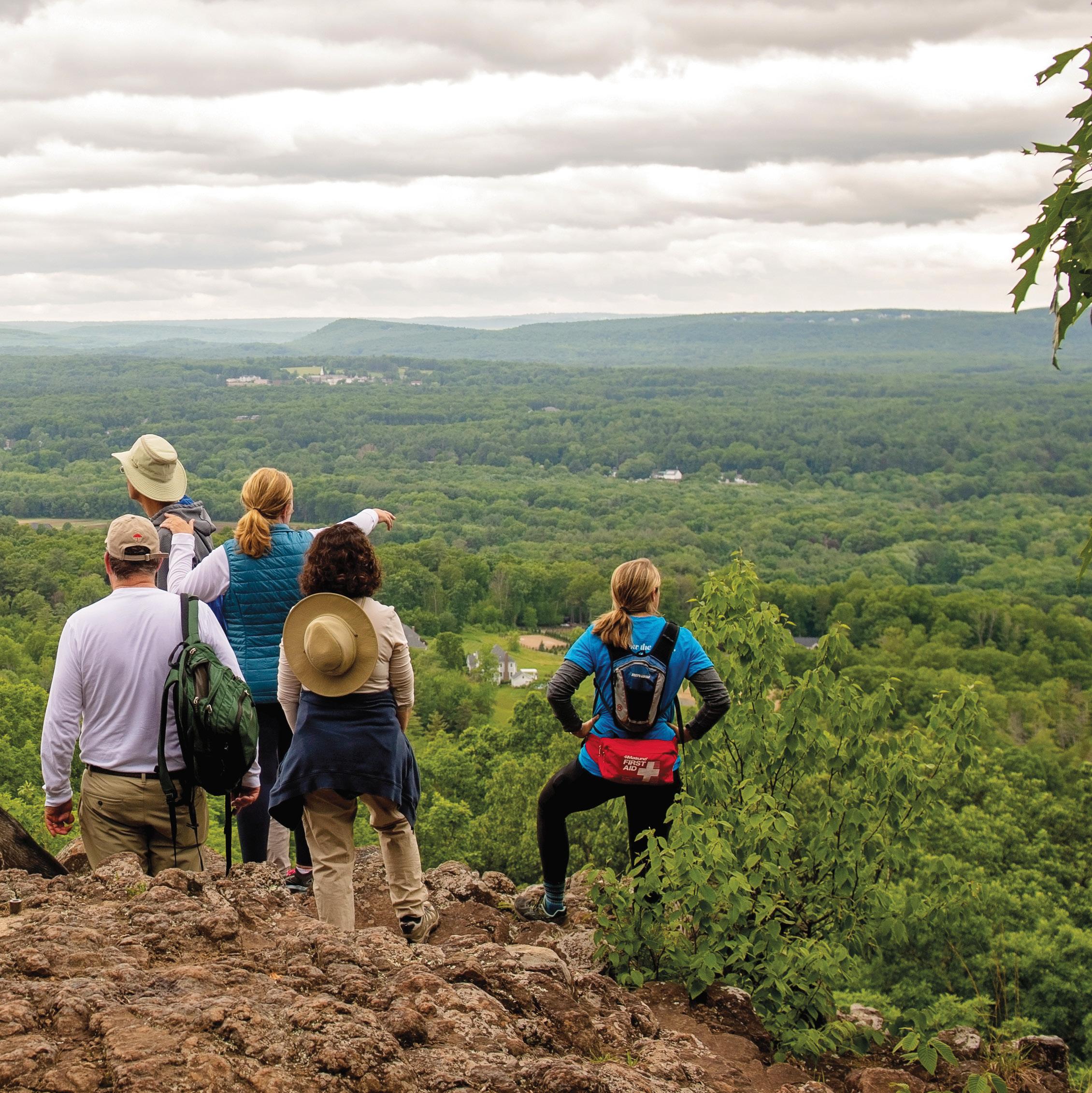
DelightfulL ights
Written by Laurie D. Morrissey
Photos by Radim Schreiber | FireflyExperience.org
One summer night more than a century ago, a Scottish writer was strolling on a lakeside path and saw tiny twinkling lights. Enchanted, he named one of them Tinkerbell. Thanks to J.M. Barrie, I always think of fairies when I see the silent display of fireflies.
Humans have always been intrigued by these luminous insects. It’s easy to think them magical, since they don’t seem to exist until dusk. Even then, they are fairly elusive—unlike mosquitoes, which emit an annoying buzz and like to suck your blood. Whether you call them fireflies or lightning bugs, they are fascinating creatures.
Despite the name, fireflies are not flies. They’re winged beetles classified under Lampyrida, a family of insects within the beetle order Coleoptera. There are about 2,000 firefly species worldwide, as many as 150 in North America.

12 Connecticut Woodlands
Above: Synchronous fireflies (Photinus carolinus) are one of only a couple of North American species who synchronize their flashing light patterns as seen in this long exposure image.
Photinus pyralis, known as the eastern firefly, is believed to be the most common species of all, and it is the one we are most likely to encounter in Connecticut. In peak firefly season—mid-June through mid-July—they are most noticeable at twilight and in early evening, with their yellow-green lights blinking close to the ground in meadows and forest edges. The eastern firefly is about a half inch long, with yellow margins along its black wing covers and a black dot in the center of its pinkish-yellow head shield. Another common name is big dipper firefly, due to the characteristic flight of the male. While females rest on the tips of reeds and grasses, males swoop through the air in a J shape, lighting on the upswing to signal their availability as mates.

Because it is so common, more is known about P. pyralis than any other firefly in the world. Sara Lewis, a Tufts University evolutionary ecologist who grew up in Woodbridge, Conn.,

ctwoodlands.org 13
Sara Lewis in the field.
Photo by Dan Perlman.
is one of the world’s experts, having published hundreds of research papers and the book Silent Sparks: The Wondrous World of Fireflies. She also presented a TED talk, “The Loves and Lives of Fireflies,” that has more than a million views.
“Beneath their gentle façade, fireflies’ lives are surprisingly dramatic,” says the self-professed firefly junkie. “They’re full of spurned advances, expensive nuptial gifts, chemical weapons, elaborate subterfuge, and death by exsanguination!” (That’s a fancy word for blood loss. Some females prey on males of a different genus, ingesting their blood to steal some of their defensive steroids for themselves.)
Fireflies spend their early life underground feasting on earthworms, snails, and soft-bodied insects, many of which are several times their size. Eastern fireflies spend one to three years in this larval stage. They then spend about two weeks as pupae before moving on to adulthood. Their adult life is brief—just a few weeks—but for most of us, this is the stage
in which we recognize them. This is when they begin what Lewis calls their courtship conversation: precisely controlled flashes used to locate mates.
Fireflies are, she says, a beautiful example of “the creative improvisation of evolution.” When a firefly flashes, it is transforming chemical energy into light. This bioluminescence likely evolved to serve as a warning to potential predators, saying “I don’t taste good!” Over millions of years, these lights evolved into a communication tool powered by a chemical reaction between luciferase (an enzyme) and luciferins (molecules that produce light). The process occurs in special organs in the firefly’s abdomen.
When a female firefly sees a flash she likes, she aims her lantern in the direction of her potential mate and responds with flashes of her own. The mating pair spends all night together, Lewis explains, while the male delivers not only sperm but also a nutrient-filled package called a “nuptial

14 Connecticut Woodlands
gift” that is essential to provisioning the eggs. Over many summers of research, Lewis and her colleagues determined that longer flashes are associated with larger nuptial gifts, and thus superior nutrition for eggs. Females make their mate selections accordingly.
Different species have different flash patterns, and some do not flash at all. One of the first insects to appear in spring is Ellychnia corrusca, known as the winter dark firefly or diurnal firefly. When the days start to lengthen and daytime temperatures rise, you may see this beetle slowly moving about in ridges and fissures in the bark of a tree or clustering around sap flows. A set of orange parentheses on its head is an identifying mark. As the weather warms, these fireflies fly slowly along in the understory, largely unnoticed. The only time they come close to living up to their name is during their larval stage, which they spend underground eating, growing, and (faintly) glowing.
In some firefly species, the males synchronize their flashes. Viewing the synchronized firefly display of Photinus carolinus in Great Smoky Mountains National Park is so popular that passes are obtained through a lottery.
Andy Moiseff, a professor of physiology and neurobiology at the University of Connecticut, studies how the brain and nervous system control an animal’s behavior. “Watching fireflies is itself just a calming activity, but as a scientist I look beyond the beauty and uniqueness of the flashes,” he says. “For me, they provide insight into how an animal, in this case a flying insect, can evolve mechanisms that allow it to perform complex behaviors that allow the individuals and the species to survive. In the firefly, this all happens in a brain that is only 1-2 mm in size. It’s quite amazing when you think about it.”
One of Moiseff’s areas of research is the effect of light pollution on fireflies. Fireflies are in decline, and scientists attribute this partly to the overuse of night-time lights, which interfere with the fireflies’ courtship activities. Habitat destruction and pesticide use are also likely culprits.
There are plenty of places to watch the firefly display, but one notable spot is the Marvin, Massarella, and Friends Firefly Sanctuary (newcanaanlandtrust.org/firefly) in New Canaan. According to New Canaan Land Trust staff member Elle Smith, more than 500 people visit during peak season.
“People are absolutely astounded by the beauty of the fireflies,” she says. “The staff and board of the Land Trust are still in awe of this phenomenon even after years with the organization. It’s one of the most anticipated summer events in town, and our registration frequently sells out within a day.”
There are a few things firefly fans can do to ensure that this summer light show is never extinguished. Experts recommend turning off outdoor lights, leaving unmown areas, and avoiding the use of pesticides and chemical fertilizers. When watching fireflies, avoid using a headlamp or flashlight. If you need a flashlight while walking, cover the lens with blue cellophane since fireflies’ eyes are less sensitive to blue light. Catching them in a jar is not harmful if they are released within a couple of hours. Ways to help fireflies recover are detailed in Sara Lewis’ book, and on the website firefly.org
Scientists are still learning about the complex lives of fireflies, and believe that many species are yet unknown. With more public awareness and with protections in place, maybe those of us who have fond memories of firefly watching as children will enjoy the same spectacle with our grandchildren.
Laurie D. Morrissey is a New Hampshire-based writer of articles, essays, and poetry. Her work has appeared in Connecticut Woodlands since 2016, when she wrote about her father, state park ranger Bill Dougal. Her writing has appeared in Northern Woodlands, Art New England, New Hampshire Home, Appalachia, and numerous poetry journals.

ctwoodlands.org 15
6
“Beneath their gentle façade, fireflies’ lives are surprisingly dramatic. They’re full of spurned advances, expensive nuptial gifts, chemical weapons, elaborate subterfuge, and death by exsanguination!”
,
Sara Lewis
Many Paths Up the Mountain
 By Greg Gregory
By Greg Gregory
Like most kids, I grew up hearing messages from the media, my peers, and family about what my body was supposed to look like—where it should be smaller, where it should be bigger, where it should have a different amount of hair—and like most people these messages had an impact on how I felt about myself. Unlike the majority though, I’ve also suffered my whole life from gender dysphoria. Put simply, gender dysphoria is the emotional pain caused by one’s personal concept of their gender not matching their physical sex. Until I started to socially and medically transition when I was 25 years old, I lived with both the discomfort of feeling like I had failed to have the female body that society valued and the deep distress of knowing that I shouldn’t be in a female body at all.
It’s difficult to describe what gender dysphoria feels like to someone who hasn’t experienced it. Seeing my body or hearing my voice made me feel ashamed and disgusted. Sometimes I had awful fantasies of catching an illness that would mean losing the body parts I hated. For many years I never socialized outside school or work, flirted with disordered eating, and had severe depression and anxiety. Tragically, I was not the only one who felt this way. A staggering 40% of transgender people have attempted suicide and 82% have experienced suicidal thoughts. Eventually I realized that for me the only path forward was to transition. Many people don’t get to make this decision. Best practice gender-affirming healthcare is currently banned in 18 states and there are more than 500 anti-trans bills working their way through state legislatures.
I grew up in a very outdoorsy family. We camped, hiked, and bicycled, but we were also lucky to have our own small patch of woods. We were free to explore and play outside where my siblings and I built forts to defend against pirates, dug holes to trap the Easter bunny, and made magic potions out of mapleleaf viburnum berries. The forest was a place of freedom and creativity. When depression hit in my teens, I sought refuge in nature. So after I got my driver’s license I started going to Sleeping Giant and soon bought a copy of the Connecticut Walk Book. The first hike I chose from the book was the Mad River section of the Mattatuck Trail. I’ll always remember the feeling of discovery when I saw the choppy river snaking around enormous moss-covered boulders. I realized there must be unspeakably beautiful places all over Connecticut.
16 Connecticut Woodlands
The mental health benefits of time spent in nature are well-documented. According to the American Psychological Association, spending time outdoors improves mood, reduces stress, and increases our empathy and cooperation. I have no doubt that my countless hours on the trail have given me a mental boost, but I can’t credit the mere presence of trees and dirt. As a solo hiker, I could spend hours in the woods and never see another person. There was no reason for me to worry about what my face looked like, how my voice sounded, or if my chest was noticeable. Hiking was a break from the constant weight of dysphoria.
Of course, exercising also changed my body in ways that I loved. My fitness improved and I started to notice muscle definition in my calves when I planted my foot on the truck door to tie my boots. Making it to the top of a steep hill became easier; climbing a complicated scramble became fun. I still didn’t like the way my body looked, but I was so proud of what it could do. As someone who had never enjoyed anything my body had to offer, I felt an immense source of joy.
In some ways, coming out and transitioning brought different problems even though it immediately gave me the new and incredible experience of gender euphoria. Transitioning medically is a gradual process. There was a time period where I felt like I stood out to others in public as immediately identifiable as transgender. Some situations, such as staying in hostels, traveling through rural areas to get to isolated peaks, and leaving my truck—which is covered in pride stickers—at trailheads, made me afraid for my safety. I still prefer to pay for a private room or sleep in my tent rather than share a bunkhouse or lean-to.
When I heard about the Master Naturalist course at the Goodwin State Forest, I was initially hesitant to sign up because I hadn’t changed my legal name yet. If there hadn’t been a clear option on the application to indicate my correct name and pronouns, I may not have attended what ended up being a life-changing experience. I learned lots of ecological facts of course, but the most important thing I learned there was how to be enthusiastic again. We don’t get many opportunities as adults to be curious and excited about the natural world. During one of the more memorable classes on a field trip to a nearby preserve, our teacher would suddenly dash off the trail to show us a bigleaf magnolia tree growing outside its native range or point at the ground to show where he’d once found a pile of clam shells. It had been a long time since I’d seen an adult man be so openly joyful. It’s an energy that I try to bring with me every time I go outside.
In October 2021, I was finally able to have top surgery, or a double mastectomy. Recovering from surgery turned out to be much more painful and emotionally difficult than I’d expected. Rather than resting for the recommended six weeks, I hiked the 110-mile Connecticut section of New England National Scenic Trail, or NET, in a series of out-and-back day hikes at an absolutely glacial pace. The smell of dead leaves and the drive to finish were better medicine than anything the pharmacy had given me. I felt an incredible sense of accomplishment as I walked onto Long Island Sound at sunset on the last day. I took my first selfie without feeling shame, one that I knew I’d be able to look at years down the road. Then, for the first time, I changed my sweaty shirt standing in the parking lot next to my truck, something I’d been looking forward to doing for years.
For the young trans folks reading this essay, I hope you find something you love as much as I love hiking, and that it brings you joy and confidence. There is a future in which you’re a happy, supported trans adult.
If you want to start exploring but don’t know how, check out the Venture Out Project or grab your own copy of the Connecticut Walk Book.
Greg Gregory is a veterinary technician and a Master Naturalist. He has visited every Connecticut state park and forest. His favorite CFPA trail is the Housatonic Range Trail.
If you are experiencing suicidal thoughts or if you just need someone to talk to, trained counselors are available to help 24/7 at thetrevorproject.org.
ctwoodlands.org 17
Hiking was a break from the constant weight of dysphoria.
Floods, Fires, and Food: Combating Eco-anxiety in a Changing Climate
 By Jennifer Sprague
By Jennifer Sprague
When Austin Serio thinks about the future of our planet, he thinks about floods, fires, and food. “How are my kids going to get food that nourishes them?” he asks.
Katharine Lange worries about where that food will come from, how it will remain affordable, and how our species and seasons will change.
Keila Silva is anxious that the resources we depend on will be inadequate to sustain us.
Serio, Lange, and Silva are not alone. A small but growing number of Americans are anxious about the climate crisis and feeling what is increasingly referred to as climate anxiety or eco-anxiety. According to a 2022 study from Yale University’s Program on Climate Change Communication, 9 percent of Americans reported feeling down, depressed, or hopeless for at least several days out of the last two weeks because of global warming, and 8 percent of Americans say they are or would be interested in seeking counseling to discuss feelings about global warming.
Among young people, the numbers tell an even more striking story. A global survey by The Lancet Planetary Health of 16 to 25-year-olds found that more than 50 percent of respondents reported feeling sad, anxious, and afraid when they think about climate change. More than
18 Connecticut Woodlands
A growing number of Americans are feeling anxious and stressed about the climate crisis. One way to manage such emotions is to get more involved in creating positive change.
“I’ve become more hopeful because I see people working really hard and I’m seeing their successes. I’ve also become more stressed and worried because I am close to the data.”
Katharine Lange
one in four said their feelings about climate change negatively affected their daily life and functioning, and 68 percent said the future is frightening.
Lange, who grew up in Lebanon and graduated from the University of Connecticut, works in environmental policy for the Massachusetts Rivers Alliance. She describes working in the environmental field as a double-edged sword.
“I’ve become more hopeful because I see people working really hard and I’m seeing their successes,” she said. “I’ve also become more stressed and worried because I am close to the data. With greater understanding comes that picture of how bad things are.”
Lange treasures her childhood memories spending summers at Girl Scouts of Connecticut’s Camp Laurel where she grew to love the outdoors. She thinks a lot about her “sense of place” and how what she loves about New England is changing.
“A lot of my memories from growing up are so tied to the season,” says Lange. “That scarf and hat I wore in the winter; fall on a college campus. Of course, we will still have seasons, but they will be different.”
What Lange describes is solastalgia, a feeling of nostalgia for one’s home environment and the way things used to be. The concept of solastalgia comes from the Australian philosopher Glenn Albrecht, who describes it as “the homesickness we feel while still at home.”
“I have such a fondness for eastern white pines and Atlantic cedars, and crocuses in the spring and lupines in June,” Lange said. “To have those key species change is going to be scary.”
Serio, who grew up in Simsbury, is a member of the Chicoran Shakori tribe of South Carolina. He works for the Urban Indigenous Collective, an organization that supports access to culturally tailored health and wellness services for Indigenous peoples in the greater New York City area, and is the cofounder and CEO of ShockTalk, a telemental health platform for Indigenous peoples.
Indigenous peoples and other marginalized communities are disproportionately impacted by the physical and mental health implications of climate change, according to the International Journal of Mental Health Systems. In these same communities, mental health services are often inadequate, creating greater risk for climate anxiety.
As Serio grapples with the historical traumas committed against Indigenous peoples and the impacts of settler colonialism, climate change can feel like another personal attack for someone who considers himself “sprung from the land.”
“Being Indigenous is fundamentally about the land, part of what makes a group indigenous as opposed to being longtime occupants,” he said. “When you talk about destruction of the biosphere, it hits home in a different way because you see yourself as part of the land and as part of nature. You understand if they’re under attack, you’re under attack.”
Serio’s family left their lives as sharecroppers in the South to move north for a better life. It’s a history he carries with him, especially when thinking about the climate.
“The story of folks going from one place to another for a better life is very common in America,” he said. “I know how hard my parents worked, so I am thinking about my descendants and what is happening to the planet.”
Many Indigenous communities think in terms of seven generations three generations forward and three generations back, says Serio.
“The goal is to be a good ancestor,” he said. “Think about how many people had to work hard for you to be here right now. We’re all playing a role for our future descendants. That’s something I think about in terms of the climate.”
Silva, a 16-year-old environmental justice advocate from Suffield, says her climate anxiety stems from wanting to do “the most I possibly can” and hitting points of burnout.
“I know I can do more,” she said. “I tend to feel overwhelmed by my stress and anger and fear and sadness. It takes a toll at that moment.”
Starting this coming July, Connecticut public schools will be required to teach climate change, but at Suffield High School, where Silva is a sophomore, a multi-week climate change unit is already part of the curriculum. During a recent lesson on hurricanes, Silva felt the atmosphere in her classroom get heavy.
“You could feel how students were hit by it,” Silva said. ”We’re not talking about an abstract concept. These are people being affected.”
Managing climate anxiety starts with talking about it, said Silva.
“I am a big advocate for expressing these feelings,” she said. “So many of us share the sentiment but we’re not vocalizing it. Other people are going through the same thing, and we’re going to get through it together.”
Serio emphasizes the importance of connection to the land.
“It’s about being able to see yourself in relation to the world and the non-human forces in this world,” he said. “You are connected, and you are a part of something bigger than ➨ page 20

ctwoodlands.org 19
Cultivating Future Environmental Leaders One Hike at a Time
In May, CFPA welcomed over 600 students from Windham Middle School to the James L. Goodwin Conservation Center in Hampton, Conn., where they spent the day exploring forest, pond, and meadow ecosystems, learning how to build a campfire and read trail blazes, and practicing good hiking etiquette and safety, all while gaining the mental and physical benefits of being outdoors. Now in its sixth year, the annual program, funded by a grant from the Community Foundation of Eastern Connecticut and led by CFPA volunteers and staff, featured new activities, such as fishing in Pine Acres Pond and learning how to pitch a tent. “We are working to develop the next generation of environmental leaders one hike at a time,” said Beth Bernard, CFPA Education Director.
“All of our students have been able to hike, learn about habitats, experience wildlife, and spend time with peers in an outdoor experience. Students were also able to make connections between the outdoors and the wildlife and with science curriculum that they explored in the class setting,” said Marcus Ware, Windham Public Schools Executive Director of Strategic Initiatives. “With very little funds to support excursions such as these to enhance student learning, Windham Middle School is very appreciative of this opportunity for all of the students to take part. In simple words, it is what all students should experience in their middle school years.”
Floods, Fire, and Food, continued from page 19
yourself. We each hold a piece of the puzzle and the best thing you can do is grab onto that piece and do the best you can with it.”
Lange also addresses her climate anxiety with action. She believes that each person can influence something they care about with something they’re good at.
“You don’t need to be a lawyer or a scientist,” she said. “If you care, that is the only qualification you need.”
Lange offers three paths for how to approach climate anxiety in daily life. First, she says, normalize talking about it.
“People think about climate change as a global thing, but we know that we are experiencing impacts here,” she said.
“Bring it up in conversation; talk about it with your friends.”
Second, contact your elected officials, says Lange.
“I can tell you 100 percent that they are always looking for people in their districts to share their concerns,” she said. “It is their job to improve the things where you live. They can’t do that unless they know what our concerns are.”
Third, get plugged into local volunteer groups, such as CFPA, a land trust, or a youth group.
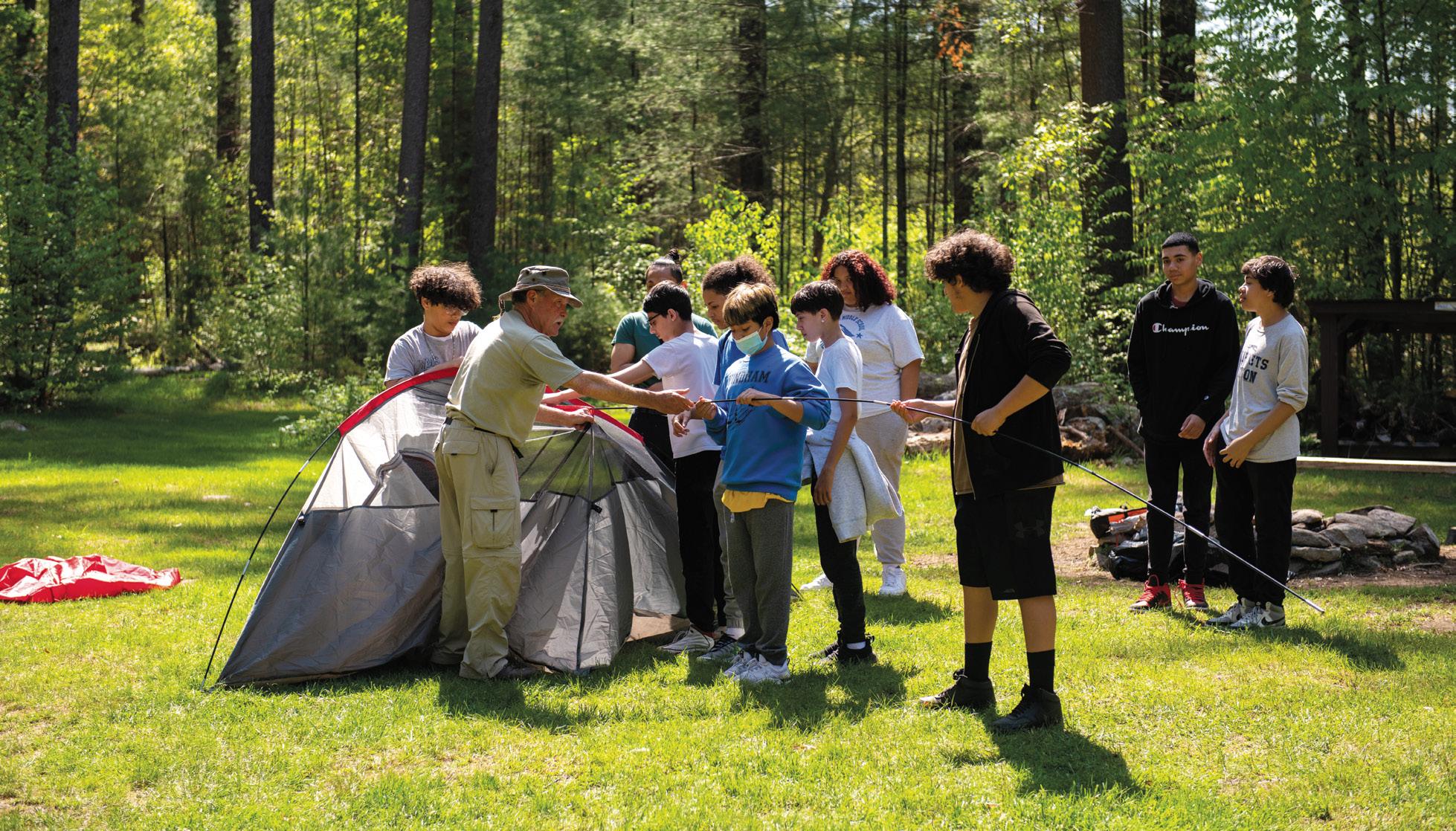
“The best way to manage your stress and anxiety is to act on it,” Lange says. “And best to act on it with company.”
Jennifer Sprague is a marketing specialist and freelance writer. She is on the board of the Meriden Land Trust. Her favorite outdoor activities are snowshoeing and camping.
20 Connecticut Woodlands
Updates CFPA
Photo by Jake Koteen
Give the Gift of Belonging!
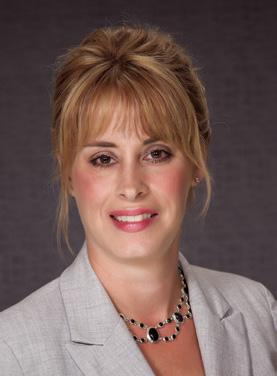

Membership at CFPA is about being included. Whether it’s an education program, a trail work party, or just hiking with a group of friends, YOU create the CFPA community. Invite your friends to join in on the fun by becoming a member, or better yet, give them the gift of membership.
Membership at CFPA is about being included. Whether itʼs an education program, a trail work party, or just hiking with a group of friends, YOU create the CFPA community. Invite your friends to join in on the fun by becoming a member, or better yet, give them the gift of membership.
Join, renew, or give a membership at www. ctwoodlands.org/join






Join, renew, or give a membership at ctwoodlands.org/donate

LOANS FOR BUILDING A COUNTRY LIFE HOMES • HOME CONSTRUCTION LAND • TIMBERLAND Breezeway. Farm Credit East NMLS No. 522993 CountryLivingLoans.com Heather Allen MLO NMLS No. 550995 78 Hartford Pike, Dayville, CT 800.327.6785 Heather.Allen@CountryLivingLoans.com Sandra Pearson MLO NMLS No. 255034 240 South Rd., Enfield, CT 800-562-2235 x8177 Cell 413-348-4210 Sandra.Pearson@CountryLivingLoans.com ctwoodlands.org 21
Ferrucci & Walicki, LLC
Land Management Consultants
Environmental Stewardship and Land Management since 1982
• Forest & Open Space Management Services
• Property Tax Reduction (PA 490 & Chapter 61)
• GIS Mapping

• Forest & Wildlife Habitat Improvement
• Timber Inventories & Appraisals
• Professionally Managed Timber Harvests
• Environmental Oversight
• Watershed & Utility Land Management
• Recreation Plans & Implementation
• Forest Stewardship Plans


6 WAY ROAD MIDDLEFIELD, CT 06455
860-349-7007 FAX: 860-349-7032
EMAIL: FW@FWFORESTERS COM
WWW.FWFORESTERS.COM
Satellite Offices in Connecticut: HAMDEN, NEW BRITAIN
Forestry Staff: ERIC HANSEN, CT CERTIFIED FORESTER F-720 TOM MCGRADE, CT CERTIFIED FORESTER F-1314

22 Connecticut Woodlands Purchasing Standing Timber.
Wills, Trusts, Estate Planning and Elder Law Succession Planning, Conservation Easements and Charitable Giving, Representation of Executors and Administrators – – –Attorney Norbert W. Church, Jr. 250 W. Main St., Branford, Connecticut 06405 203-488-0300 churchandchurch@yahoo.com at-home, telephone, or Zoom consultations Celebrating over 40 years of practice in Connecticut
www.hullforest.com
Pathways
In1914,
the actor and playwright, William Hooker Gillette, began construction on his retirement home on the southernmost hill of a range known as the Seven Sisters overlooking the Connecticut River in East Haddam. Best known for his portrayal of Sherlock Holmes—including 1300 stage performances over more than three decades—Gillette, who grew up in Hartford’s Nook Farm neighborhood alongside such celebrities as Mark Twain and Harriet Beecher Stowe, conceived of many of the features that today are commonly associated with the fictional detective—the deerstalker cap, Inverness cape, curved pipe, and magnifying glass. He also coined the phrase, “Elementary, my dear fellow,” which eventually became “Elementary, my dear Watson.”
Gillette’s home, a sprawling 24-room, 14,000-square-foot mansion that resembles a medieval castle, took five years to complete and at the time cost $1.1 million. Built with local fieldstone and supported by steel I-beams, the house featured all the modern conveniences of the day: electricity, running hot and cold water in each of its many bathrooms, and central heating from a coal-fired boiler. There was also an art gallery, library, greenhouse, and two towers. The interior of the home was adorned with hand-carved southern white oak woodwork, Quezal globes, and two Tiffany lamps. Albert Einstein, Helen Hayes, and Charlie Chaplin were reportedly amongst Gillette’s guests at what was officially called the “Seventh Sister Estate.” In 1943, the State of Connecticut, with support from the Connecticut Forest & Park Association, purchased the 122-acre property from the Gillette estate for $30,000, and a year later Gillette Castle State Park opened to the public. The home recently underwent a 3-year, $480,000 renovation and tours are once again available.

In addition to his acting, Gillette had a lifelong love of trains. In 1927, he constructed a quarter-scale, narrow-gauge railroad on the estate. The three-mile-long track, complete with bridges, turnarounds, a tunnel, and a railroad station, offered riders expansive views of the Connecticut River. Today, many of the tracks have been converted into hiking trails, but visitors can still view the steam and electric engines that once pulled Gillette and his guests along the ridgeline.

ctwoodlands.org 23

























16 Meriden Road Rockfall, CT 06481-2961 Nonprofit Organization US Postage PAID Hartford, CT Permit #1121
the Master Woodland Manager Program
our forests,
we
your
Donate to continue providing valuable educational opportunities.
YOU ... OWN OR MANAGE WOODLANDS?
TO LEARN HOW WOODLANDS CAN SUPPORT WILDLIFE AND FIGHT CLIMATE CHANGE?
TO SUPPORT YOUR LOCAL ECONOMY?
is currently accepting applications for the Master Woodland Manager Program. During this year-long program, participants will gain the skills to manage woodlands for wildlife, their communities, and future generations.
today at ctwoodlands.org/mwm
Programs like
are essential to conserving
but
need
support.
DO
WANT
WANT
CFPA
Apply




 By Jennifer Sprague
By Jennifer Sprague























 By Greg Gregory
By Greg Gregory
 By Jennifer Sprague
By Jennifer Sprague













































